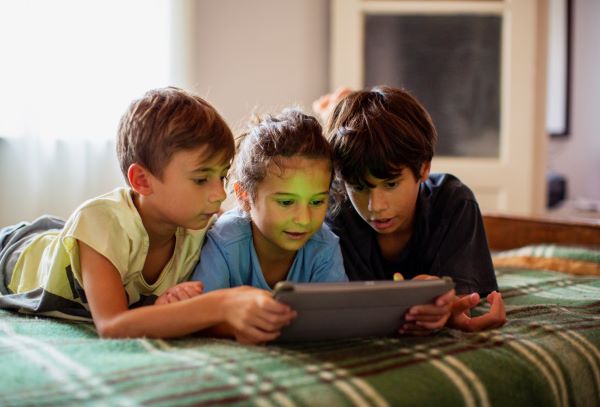Many Aussie adults will have fond memories of getting eye checks as a kid. You got to put on some funky glasses and play what felt like some pretty fun games, trying to read the smaller and smaller text on the wall chart or picking what circle shone brightest.
Sadly, in more recent years, routine eye care checks are picking up rising cases of myopia (short-sightedness) in children, and at younger ages than ever before.
While some sight-related conditions are genetic and may not be preventable, others may be caused or made worse by external factors, such as spending too much time on devices and screens.
Thankfully there are ways to slow or even stop the onset of short-sightedness in kids.
What is myopia?
Myopia is more commonly known as near-sightedness or short-sightedness. The condition means it’s hard to see things from far away. So, while your vision is clear when reading a book, a movie screen or road sign might appear blurry.
Myopia occurs when the shape of your eye, or part of it, makes light focus in the wrong place. Instead of focusing on the retina, which is at the back of your eye and helps you see clearly, the light focuses in front of it, making objects look blurry and out of focus.
Short-sightedness is on the rise globally, with health experts predicting that half of the world’s population will be affected by myopia by the year 2050.
What causes short-sightedness?
The exact causes of short-sightedness are unknown. However, if one of your parents is short-sighted, you have a higher risk of being diagnosed.
While genetics aren’t preventable, other risk factors of myopia may be lifestyle and environmental related, including:
- excessive screen time
- excessive near work, such as reading and other close-work activities
- lack of time spent outside
- lack of natural light exposure.
Does too much screen time affect your eyesight?
Screen time may be one of the worst culprits in the rise of myopia in children. Not only is it a sedentary, near-work activity, but it also limits time spent outside in natural sunlight, both protective factors for eye health.
Children are also spending more time on screens. New research shows that, on average, children aged 5-12 years now spend 3.5 hours every day on screens, including phones, tablets, gaming consoles and laptops. That’s 3 times the amount recommended by the World Health Organisation.
Read more: Are you getting too much blue light exposure?
Does my child have myopia?
One of the best ways to keep an eye on your child’s sight is to get regular eye tests, says Specsavers optometrist Michelle Phan.
“We encourage parents, carers and teachers to ensure children have their first eye test before starting school to detect and correct or manage any issues, so they don’t go untreated,” says Michelle. “Children’s eyes are still developing during their schooling years, and they can’t always tell you if they may not be able to see properly.”
Some things to look out for that might indicate your child is having issues with their vision include:
- complaining about headaches or blurred vision
- squinting to see objects in the distance
- difficulty reading from the whiteboard in the classroom
- needing to sit close to the TV to watch it.
If you notice any of these symptoms it’s best to act quickly.
“I recommend booking an appointment with an optometrist immediately rather than waiting until their next check-up,” says Michelle.
How to prevent myopia in children
While not all cases of myopia are preventable, there are ways to support your child’s eye health.
Spending time outside is a big one. Studies show that engaging in exercise outside for between 2-3 hours in one block can significantly reduce the rates of myopia in kids.
While any physical activity is great for overall health, for children’s eye care particularly, being outside in natural light may be key. Taking the kids to the beach, on a hike, or playing a few games of basketball, netball or soccer are all great ways to get them outside.

100% back on optical on eligible extras
At Medibank we think you deserve to see the world clearly. That’s why when you join eligible Medibank extras you get 100% back on optical items at all recognised providers up to annual limits.*
Having eye checks every 2 years (unless your optometrist recommends more) is also important.
Specsavers research shows that nearly 1 in 3 parents of children under the age of 9 have never had their kids’ eyes checked. As well as making sure your child’s eyesight is tracking well, regular eye tests can pick up other health or sight conditions and ensure appropriate treatment which can prevent long-term issues.
Read more: 6 ways to take care of your eyes
Reducing digital eye strain in kids
It can be tough to police screen time as a parent. As well as game time with their friends, many children are using screens to do schoolwork or watch movies for some well-deserved downtime.
Putting your phone away at mealtimes, keeping phones and tablets out of bedrooms, and engaging in other activities (such as reading or playing a board game) are all good ways to show your kids that not everything has to revolve around a screen.
If you notice your child struggling with digital eye strain, there are some ways to help ease it.
Michelle’s top tips for reducing digital eye strain in kids (and grown-ups!) include:
1. Follow the 20-20-20 rule
This means, every 20 minutes remind children to shift their eyes to look at an object at least 20 metres away, for at least 20 seconds. The easiest way to do this is to take small ‘window’ breaks and look out at a faraway object to give tired eyes a break from the screen.
2. Get outside
Take breaks outside to play in natural light for an ideal of 2-hour blocks minimum.
3. Remind children to blink
Blinking regularly keeps the surface of your eyes from drying out. You can even turn this into a fun game.
3. Drink lots of water
Just like the rest of our bodies, eyes get dehydrated which makes them susceptible to irritation and strain.
How to best support your child’s eye health
Myopia is on the rise in children and as parents it’s important to stay vigilant.
Reducing screen time where possible, as well as following Michelle’s simple tips to reduce digital eye strain, is a good place to start.
Keeping an eye on your child and noticing any change or strain in their vision is a great way to support their eye health. If you do notice any issues book an appointment with your optometrist immediately and be sure to have regular preventative check-ups scheduled in the diary.
Want to book an eye check up for you or your child today? Find your closest Medibank Members' Choice provider here.

